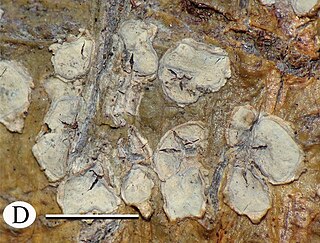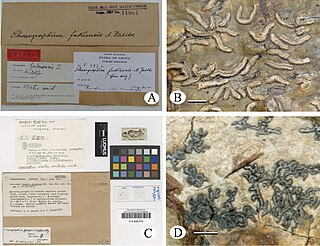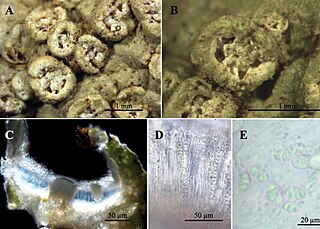
The Graphidaceae are a family of lichen-forming fungi in the order Graphidales. The family contains nearly a hundred genera and more than 2000 species. Although the family has a cosmopolitan distribution, most Graphidaceae species occur in tropical regions, and typically grow on bark.

Fissurina is a genus of lichenized fungi in the family Graphidaceae. It has about 160 species, most of which are found in tropical regions.

Thelotrema is a genus of lichen-forming fungi in the family Graphidaceae, the family to which all taxa in the former Thelotremataceae now belong.

Astrochapsa is a genus of lichen-forming fungi in the subfamily Graphidoideae of the family Graphidaceae. It has 28 species. The genus was circumscribed by Sittiporn Parnmen, Robert Lücking, and H. Thorsten Lumbsch in 2012, with Astrochapsa astroidea assigned as the type species. It was segregated from the genus Chapsa, from which it differs in having a more frequently densely corticate thallus, an apothecial margin that is mostly recurved, and the almost exclusively subdistoseptate, non-amyloid ascospores.
Wirthiotrema is a genus of lichen-forming fungi in the family Graphidaceae. The genus was circumscribed in 2010 by Eimy Rivas Plata, Klaus Kalb, Andreas Frisch, and H. Thorsten Lumbsch, with Wirthiotrema glaucopallens assigned as the type species. Wirthiotrema contains species that were formerly considered part of the Thelotrema glaucopallens species group. The genus name honours lichenologist Volkmar Wirth, "for his numerous outstanding contributions to lichenology".
Rhabdodiscus is a genus of script lichens in the family Graphidaceae. It has 36 species.
Pseudochapsa is a genus of lichen-forming fungi in the family Graphidaceae. It has 19 species. It was circumscribed in 2012 by Sittiporn Parnmen, Robert Lücking, and Helge Thorsten Lumbsch, with Pseudochapsa dilatata as the type species. Pseudochapsa differs from Chapsa it that its excipulum is typically brown. Additionally, its ascospores are mostly discoseptate and amyloid. The generic name combines the Greek pseudo ("false") with the genus name Chapsa.

Graphidales is an order of lichen-forming fungi in the class Lecanoromycetes. It contains 6 families, about 81 genera and about 2,228 species. Family Graphidaceae are the largest crustose family within Graphidales order comprising more than 2000 species, which are widely distributed in tropical and subtropical regions of the world.
Clandestinotrema is a genus of lichen-forming fungi in the family Graphidaceae. It has 17 species. They typically inhabit montane and cloud forest at higher elevations in the tropics.
Gintarasia is a genus of lichen-forming fungi in the family Graphidaceae. It has seven species, all of which are found in Australia. Gintarasia species are corticolous (bark-dwelling), crustose lichens with a thelotremoid form.
Fissurina amyloidea is a little-known species of script lichen in the family Graphidaceae. It is found in the primary rainforests of Rondônia, Brazil. It is characterized by its weakly carbonizedlirellae and thick-walled, strongly amyloid ascospores. Despite its superficial similarity to Fissurina subfurfuracea, F. amyloidea exhibits unique anatomical features that set it apart from other species within the genus.
Acanthotrema frischii is a species of corticolous (bark-dwelling) lichen in the family Graphidaceae. Found in the East Province of Cameroon, A. frischii has a smooth, olive-green thallus, and its broadly oval, glass-like ascospores. Although initially believed to represent Acanthotrema brasilianum, a Neotropical species, it was identified as a distinct species due to differences in ascospore structure.
Acanthotrema kalbii is a species of corticolous (bark-dwelling) lichen in the family Graphidaceae. First classified as a new species in 2012, the lichen is found in Costa Rica, where it grows in partially shaded areas of disturbed primary forest within the montane rainforest zone. This lichen stands out from its close relative, A. brasilianum, primarily due to the internal structure of its larger ascospores. The inaugural specimen of A. kalbii used for the species' formal description, was located on tree bark in a montane rainforest in the Las Tablas Protected Zone. The lichen is recognisable by its grey-green thallus, which varies from smooth to uneven and produces slender isidia, tiny outgrowths, up to 2 mm in length.
Nitidochapsa is a genus of lichen-forming fungi in the family Graphidaceae. It has five species of corticolous (bark-dwelling), crustose lichens.
Pycnotrema is a small genus of lichen-forming fungi in the family Graphidaceae. Its two species are characterised by their small, rounded apothecial pores.

Glaucotrema is a genus of lichen-forming fungi in the family Graphidaceae. It has five species.

Mangoldia is a genus of lichen-forming fungi in the subfamily Graphidoideae of the family Graphidaceae. It contains four species of corticolous (bark-dwelling) script lichens.
Melanotopelia is a genus of lichen-forming fungi in the family Graphidaceae. It has four species of corticolous (bark-dwelling), crustose lichens. This genus includes species characterised by dark pigmentation in their exciple, non-amyloid ascospores, and specific secondary metabolites.
Corticorygma is a monotypic fungal genus in the subfamily Graphidoideae of the family Graphidaceae. It contains a single species, the corticolous (bark-dwelling) crustose lichen Corticorygma stellatum. This script lichen is found in the shaded understory of rainforests in the Brazilian states of Rondônia and Paraná.







